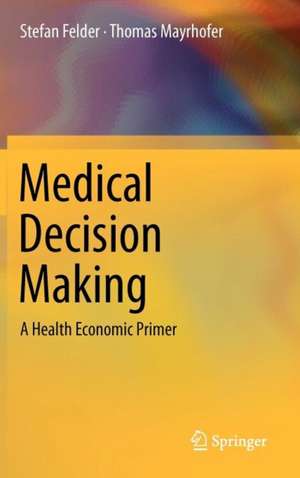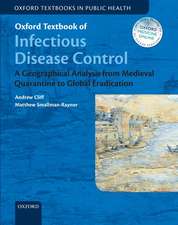Medical Decision Making: A Health Economic Primer
Autor Stefan Felder, Thomas Mayrhoferen Limba Engleză Hardback – 22 iul 2011
| Toate formatele și edițiile | Preț | Express |
|---|---|---|
| Paperback (2) | 453.39 lei 6-8 săpt. | |
| Springer Berlin, Heidelberg – 9 mai 2018 | 453.39 lei 6-8 săpt. | |
| Springer Berlin, Heidelberg – 6 apr 2023 | 457.24 lei 6-8 săpt. | |
| Hardback (2) | 374.37 lei 38-45 zile | +28.16 lei 6-12 zile |
| Springer Berlin, Heidelberg – 5 apr 2022 | 461.21 lei 3-5 săpt. | +28.16 lei 6-12 zile |
| Springer Berlin, Heidelberg – 22 iul 2011 | 374.37 lei 38-45 zile |
Preț: 374.37 lei
Nou
Puncte Express: 562
Preț estimativ în valută:
71.64€ • 76.60$ • 59.73£
71.64€ • 76.60$ • 59.73£
Carte tipărită la comandă
Livrare economică 14-21 aprilie
Preluare comenzi: 021 569.72.76
Specificații
ISBN-13: 9783642183294
ISBN-10: 3642183298
Pagini: 240
Ilustrații: XVII, 200 p.
Dimensiuni: 155 x 235 x 20 mm
Greutate: 0.49 kg
Ediția:2011
Editura: Springer Berlin, Heidelberg
Colecția Springer
Locul publicării:Berlin, Heidelberg, Germany
ISBN-10: 3642183298
Pagini: 240
Ilustrații: XVII, 200 p.
Dimensiuni: 155 x 235 x 20 mm
Greutate: 0.49 kg
Ediția:2011
Editura: Springer Berlin, Heidelberg
Colecția Springer
Locul publicării:Berlin, Heidelberg, Germany
Public țintă
Upper undergraduateCuprins
1 Introduction.- 2 Basic Tools in Medical Decision Making.- 3 Expected Utility, Risk Aversion and Prudence.- 4 Treatment Decisions Without Diagnostic Tests.- 5 Treatment Decisions with Diagnostic Tests.- 6 Treatment Decisions Under Comorbidity Risk.- 7 Optimal Strategy for Multiple Diagnostic Tests.- 8 The Optimal Cutoff Point of a Diagnostic Test.- 9 A Test's Total Value of Informations.- 10 Valuing Health and Life.- 11 Conclusion.
Notă biografică
Prof. Dr. Stefan Felder holds the Chair of Health Economics at the Economics Department of the Duisburg-Essen University. He studied economics and sociology, received his Ph.D. and his venia docendi from the University of Bern. He worked and taught at the University of Western Ontario (1990/92), University of Zurich (1992/1996) and University of Fribourg (1993/95) before joining the Faculties of Medicine and Economics at the University of Magdeburg in 1997. He currently is the general secretary of the German Association of Health Economics. From 2011, he will take over the Endowed Chair of Health Economics at the University of Basel, Switzerland.
Thomas Mayrhofer is a Research Associate in the Doctoral Program in Economics at the Chair of Health Economics, University Duisburg-Essen.
Thomas Mayrhofer is a Research Associate in the Doctoral Program in Economics at the Chair of Health Economics, University Duisburg-Essen.
Textul de pe ultima copertă
This textbook offers a comprehensive theory of medical decision making under uncertainty, combining informative test theory with the expected utility hypothesis. The book shows how the parameters of Bayes’ theorem can be combined with a value function of health states to arrive at informed test and treatment decisions. The authors distinguish between risk neutral, risk averse and prudent decision makers and demonstrate the effects of risk preferences on physicians’ decisions. They analyze individual tests, multiple tests and endogenous tests where the test result is determined by the decision maker. Finally, the topic is examined in the context of health economics by introducing a trade-off between enjoying health and consuming other goods, so that the extent of treatment and thus the potential improvement in the patient’s health become endogenous.
Caracteristici
Basic chapters on MDM tools and expected utility theory appeal to students of both medicine and economics A comprehensive text on MDM under uncertainty for economists and physicians alike 54 illustrations, 18 boxes and further illustrative materials help the reader to grasp complex issues 31 Exercises and references for each chapter provide the opportunity to delve further into the subject matter













